Химические науки. Рубрика в журнале - Бюллетень науки и практики
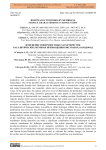
Bioethanol to hydrogen membrane surface characteristics change study
Статья научная
The problem of the gradual transformation of the modern economy towards greater production and consumption of ‘green’ energy requires a significant revision of existing technologies. One of the possible ways to develop green energy is the use of hydrogen as the most environmentally friendly fuel. Hydrogen can be obtained both by electrolysis, using solar energy, and using biorenewable raw materials, which can be used as ethanol, biogas, peat, agricultural waste. At the same time, for regions with a low level of illumination, the production of hydrogen by electrolysis of water using electricity generated by solar panels is inaccessible, and therefore the processing of biorenewable raw materials can take a leading position. Bioethanol is a large-capacity product with a proven production technology that widely uses waste from agriculture and wood processing. Ethanol can be used as a feedstock for hydrogen generation by means of catalytic pyrolysis or catalytic steam reforming. Membrane-catalytic steam reforming of ethanol with the production of hydrogen makes it possible to obtain hydrogen without the use of an additional purification step, however, the efficiency and stability of the membrane becomes the determining parameter that ensures the efficiency of the entire process. The degradation of inorganic membranes during catalytic steam reforming is closely related to the change in porosity as a result of hydrolysis of the membrane surface. In this connection, the study of the physicochemical properties of membranes during operation can make a significant contribution to the development of stable catalytic membranes for hydrogen production. The article presents the results of studying the physicochemical properties of an inorganic membrane for ethanol steam reforming by the method of low-temperature nitrogen adsorption. The Langmuir, Brunauer-Emmett-Taylor, t-plot and Barrett-Joyner-Halenda models were used to estimate the surface change. An increase in the surface area of mesopores during the operation of the membrane was determined.
Бесплатно

Catalytic properties study of mixed MFI-mord type zeolite in bioethanol transformation
Статья научная
The decrease in stocks of traditional fossil fuels contributes to the widespread growth of interest in renewable sources of raw materials and energy. Bioethanol can become a serious alternative to traditional types of fossil raw materials and fuels due to the possibility of its widespread production from agricultural waste and wood processing. Bioethanol can be used directly as a fuel, or after transformation into hydrocarbons. The transformation of bioethanol into hydrocarbons is carried out using zeolites and zeotypes of various types, while the main problem encountered for these systems is deactivation during the catalytic transformation. In this case, one of the possible solutions to this problem is the regulation of the acidic and diffusion properties of the catalytic surface of zeolites. Changing the acidic properties can contribute to a significant increase in the stability and activity of zeolites. In this case, the variation of acidic properties is possible by combining different types of zeolites. The article presents the results of a study of a mixed zeolite of the MFI type and mordenite in the reaction of the transformation of ethanol into hydrocarbons. Zeolite synthesis was carried out by a sequential method using zeolite seed grains for the synthesis of MFI structures and n-butylamine for the synthesis of a mordenite layer. The synthesized sample was tested on a flow-type setup with a tubular reactor. The effect of temperature, specific ethanol feed rate, and total pressure in the system was investigated. An increase in the reaction temperature from 350℃ to 370℃ contributed to an increase in the rate of accumulation of liquid hydrocarbons from 0.52 to 0.64 g(HC)/(g(Cat)*h), while a further increase in temperature to 430℃ contributed to a decrease in the rate of formation of liquid hydrocarbons to 0.32 g(HC)/(g(Cat)*h). An increase in the specific feed rate of ethanol from 0.5 to 2 g(EtOH)/(g(Cat)*h) contributes to a decrease in the yield of liquid hydrocarbons. An increase in the total pressure in the system from 1 atm to 15 atm promotes an increase in the rate of accumulation of liquid hydrocarbons from 0.34 to 0.83 g(HC)/(g(Cat)*h).
Бесплатно

Development of Beta zeolite template free synthesis method
Статья научная
The development of new methods for the synthesis of zeolites and the improvement of existing methods for the synthesis of zeolites in order to reduce their cost and improve the quality of the final product is an important task of modern chemistry and chemical technology. Existing methods for the synthesis of zeolites, including hydrothermal synthesis methods, are extremely time-consuming and expensive due to the widespread use of structure-forming agents. At the same time, traditional methods for solving the above problems by increasing the rate of hydrothermal synthesis by increasing the temperature are not optimal, due to the possibility of the formation of additional inorganic phases at high temperatures. Zeolite BETA is one of the most commonly used aluminosilicates both as a catalyst and as a material for creating inorganic membranes for various purposes, while the synthesis of the above zeolite is extremely long and takes from 5 to 10 days. The presented article presents the results of the development of a method for obtaining BETA zeolite by a hydrothermal method under the influence of ultrasound. A study of the influence of temperature and the ratio of silicon to aluminum in the reaction medium on the yield of zeolite is also given. It has been established that an increase in the temperature of hydrothermal synthesis from 80° C to 120 °C contributes to an increase in the yield of zeolite up to 97%. An increase in the molar ratio of silicon to aluminum, on the contrary, leads to a decrease in the zeolite yield to 15%. It is shown that the synthesis under conditions of ultrasonic treatment with a power of 6 mW/cm2 contributes to an increase in the yield of the target product by 2-4 times, and an increase in the rate of formation of BETA zeolite by 2-8 times.
Бесплатно
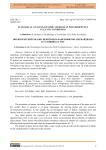
Ecological analysis of some Azerbaijan phanerophytes in ex situ conditions
Статья научная
Analyzes of the relationship of 115 species of phanerophytes used in cultural conditions (Azerbaijan) against some abiotic factors (light, temperature, water, wind, etc.) have been presented in the paper. 2 species of these taxa are hygrophytes, 56 species are mesophytes, 23 species are xerophytes, 9 species are mesoskerophytes and 25 species are xeromesophytes have been determined depending from the relationship with water according to the results of analyzes. 100 light-loving species, 15 shade-loving species, 97 wind-resistant species and 18 wind-resistant species were found as a result of the study.
Бесплатно
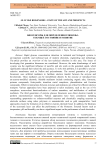
Glucose biosensors - state of the art and prospects
Статья обзорная
Rapid glucose concentration detection in technical and biological systems is an important scientific and technical task of modern chemistry, engineering and technology. The article provides an overview of the last technical solutions in this area. The issues of developing first generation biosensors are considered. However, the main disadvantage of such systems was the significant influence of ascorbic and uric acids on the generated signal, which significantly reduced their selectivity and accuracy. To solve this problem, it is possible to use ion-selective membranes such as Nafion and polycarbonate. The second generation of glucose biosensors uses artificial mediators to facilitate electron transfer between the enzyme and the electrode. These mediators can be immobilized directly by the enzyme or introduced into an enzyme-modified electrode. Suitable mediators include conducting organic salts, ferrocene, quinone compounds, ferricyanide, transition metal complexes, phenothiazine and foxazine compounds. Effective interactions between enzymes and mediators are critical for efficient electron transport. Various approaches have been proposed to tailor mediators, such as the use of Os complexes, noncovalent functionalization of carbon nanotubes, and stabilization of artificial mediators. The third generation of enzyme glucose biosensors uses direct electron transfer to perform electrochemical reduction. Various approaches have been considered, including reassembling apoproteins on cofactor-modified enzymes and electrically coupling enzymes to electrode surfaces using redox polymers or nanomaterials such as gold nanoparticles. Such approaches ensure the formation of an effective enzyme-electrode bond. In addition, the thickness of the enzymatic layer can affect the performance of the biosensor. External factors such as temperature, pH and humidity can have a significant impact on the performance of such electrodes.
Бесплатно

In situ H-ZSM-5 zeolite deactivation study in dimethyl ether to hydrocarbons transformation reaction
Статья научная
Today, catalytic processes for the synthetic fuel components production are of considerable interest for both scientific and industrial area. The transformation of dimethyl ether into hydrocarbons is one of the possible solutions for the development of a closed hydrocarbon cycle, in connection with which a wide study of this process is an important task of modern catalysis. The transformation of dimethyl ether into hydrocarbons occurs with the formation of heavy polyaromatic hydrocarbons, which are deposited on the surface of active centers, which in turn prevents the further occurrence of chemical processes on their surface. This article presents a study of the deactivation of zeolite H-ZSM-5 by the thermogravimetric method in situ. The results of experiments carried out in the temperature range from to 300 to 400 °C are presented. The accumulation of carbon deposits in the first hour of operation indicates the presence of an induction period due to the formation of the first layer of carbon deposits. Linear decontamination occurs when the first five weight percent of carbon deposits accumulate. Further accumulation of carbon deposits up to eight weight percent leads to a sharp decrease in the rate of conversion of dimethyl ether into hydrocarbons to 0.08 kg (DME) / (kg (Cat) h). In the first hour of operation, aromatic hydrocarbons predominate in the reaction medium; with increasing time, the concentration of aromatic hydrocarbons decreases, and the concentration of light olefins and alkanes increases due to carbonization of the catalyst surface. The concentration of heavy aromatic hydrocarbons with a number of carbon atoms equal to or greater than eleven has a maximum after 240 minutes of reaction. The decrease in the content of heavy aromatic hydrocarbons after 240 minutes of reaction can be explained by the sharp loss of surface acidity due to carbonation.
Бесплатно
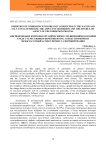
Статья научная
In this paper, the process of adsorption of phenol derivatives, polyaminopolycarboxylic acids (PFPA) and tertiary amine salt, modeled on semi-empirical ZINDO/1, on iron (available in different grades of steel in the amount of 90-97%) is presented. The structures of the phenol derivatives for the study were chosen without complicating the structure, and the isomers of the position of the substituents were chosen. The structures of polyaminopolycarboxylic acids for the study were chosen according to the structure complication. In the course of the study, the following compositions were obtained and analyzed: compositions of the complexes obtained, global and local electrophilicity values, a graph showing the dependence of the charge density on the iron atom on the protective effect. For the first time, the interclass aspect of corrosion protection will be considered, where the generality of the investigated quantum-chemical approach for different classes of organic inhibitors, which are also found in different corrosive environments, will be proved.
Бесплатно

Статья научная
Целью настоящего исследования является синтез N-ацилированных производных амида фенилуксусной кислоты и изучение корреляции между выходами продуктов и природой ацилирующего агента. Реакцию осуществляли в кислой среде, добавляя к субстанции ангидриды кислот, различающиеся длиной и разветвленностью углеродной цепи. Полученные продукты представляют значительный интерес и как биологически активные соединения и как исходные вещества для получения производных пиримидин-4(1)-она.
Бесплатно
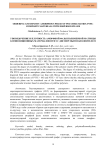
Статья научная
Discusses the impact of dispersed filler in the form of microcrystalline graphite (MG) on the formation of the supramolecular structure of the amorphous-crystalline polymeric materials the binary system of PTFE + MG. The theoretically calculated and experimental values of the composites densities are compared. The theoretical model of densities calculation takes into account the degree of crystallinity and the degree of the polymer-matrix (PM) ordering, as well as the deformation of the crystal cell in the amorphous phase. The degree of ordering and density of PM PTFE-composites amorphous phase behave in a complex manner with increasing content of dispersed filler and in a different way than with fibrous filler in the form of carbon fiber (CF). Studies of dual systems of PTFE + MG and PTFE + CF have shown that the ordering presence the amorphous phase can be considered one of the formation factors of the composite materials supramolecular structure based on amorphous-crystalline polymers.
Бесплатно
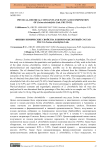
Physical-chemical constants and fatty acid composition of Zosima absinthifolia Link. fruit oil
Статья научная
Zosima absinthifolia is the only species of Zosima genus in Azerbaijan. The aim of this study was to determine the quantitative and qualitative determination of fatty acids in the fruits of the plant Zosima absinthifolia, which is widespread in Absheron, as well as to study its physicochemical and organoleptic properties, possible use in the pharmaceutical and food industries. The oil obtained from the fruits of the plant collected from the Absheron Peninsula (Bibiheybat) was analyzed by gas chromatography. The oil was obtained at 60 °C for 8 h by the extraction of the fruits in a Soxhlet extractor. The yield was 10.36%. Chromatographic analysis of the oil obtained from plant fruits allowed to determine 14 fatty acids. The main component of Z. absinthifolia fruit oil is oleic acid (74.36%). Small amounts of caprylic and palmitic acids were also found to be 8.9% and 5.39%, respectively. The lowest percentage is palmitinoleic acid (0.07%). Physical-chemical constants and organoleptic properties of Z. absinthifolia fruit oil were also analyzed and it was determined that the percentage of free fatty acids in our sample was 2.47%, the peroxide value 34.16 mg O/kg and the saponification number 200.23 mg KOH/g.
Бесплатно

Статья научная
In this paper, the process of adsorption of organic compounds of the polyaminopolyphosphonates and polyaminopolyсarbonoates (chelators or complexones) class on iron (available in steel St3S (Poland) 97%) is modeled using the HyperChem package version 8.0.7 using the semi-empirical ZINDO / 1 method. The structures of chelators (“complexones”) for the study were chosen so that the sequential complication of the molecular structure could be traced. Such an approach, as will be shown below, accurately reflects the process of corrosion protection with bacterial content by chemisorption of an organic compound on the metal surface to form a complex compound. In the course of the study, the compositions of the complexes obtained, the energies of the boundary orbitals, and a graph depicting the dependence of the charge density on the iron atom on the component of the corrosion rate that is due to chemisorption effects were obtained and analyzed. On the graph there are equations of lines.
Бесплатно
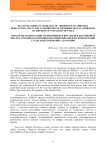
Статья научная
In the published work, the process of adsorption of organic derivatives of thiourea and dicarboxylic acids (thiourea class) modeled with semi-empirical ZINDO / 1, on iron (97% in steel St3, Poland) is presented. The structures of “thiourea” for the study were chosen so that the sequential complication of the molecular structure could be traced. Such an approach, as will be shown below, reflects with high accuracy the process of protection against corrosion with bacterial content by chemisorption of an organic compound on the metal surface with the formation of a complex compound. In the course of the study, the following compositions were obtained and analyzed: the compositions of the complexes obtained, global and local electro-filter values, a graph showing the dependence of the local electrophilicity of an arbitrary heteroatom taken by the author. The graph shows the equations of the obtained lines.
Бесплатно
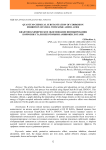
Quantum-chemical substantiation of corrosion inhibition of steel with some amino acids
Статья научная
The article describes the process of α-amino acid adsorption on iron of mild steel immersed in 0.01 M H2SO4, this process was modeled using HyperChem 8.0.8 and ZINDO/1. This method reflects the protection against corrosion by chemisorption of α-amino acid on the surface of metal to form a complex adduct, reliably. The compositions of obtained complexes, the energy of boundary orbitals, a graph depicting the dependence of the charge density on the iron atom and the energy of higher occupied molecular orbitals on the anticorrosive protective effect were obtained and analyzed. On the graphs one can see the equations of lines.
Бесплатно

Ru-содержащие катализаторы для жидкофазного синтеза Фишера-Тропша
Статья научная
Поиск новых стабильных и активных катализаторов синтеза Фишера-Тропша является одним из основных направлений производства жидких транспортных топлив из альтернативного сырья. Стабилизация активной фазы является одной из ключевых задач при разработке катализаторов гидрирования CO в жидкое моторное топливо. Эта задача может быть решена путем выбора оптимального носителя, а также метода синтеза. Настоящая работа посвящена разработке новых полимерных моно- и биметаллических Ru-содержащих нанокатализаторов для жидкофазного синтеза Фишера-Тропша. Показано, что использование 1% Ru-СПС и 10% Co - 1% Ru-СПС позволяет получать высокий выход бензиновых углеводородов диапазона C5-C9 (более 70%), обеспечивая высокую конверсию CO (до 23%). Выбранные системы на основе полимеров показали высокую стабильность в процессе синтеза Фишера-Тропша.
Бесплатно
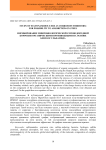
Study of sulfonamides (used as corrosion inhibitors) for possibility to adsorption on steel
Статья научная
In this paper, the process of adsorption of organic compounds of the sulfonamides class on iron (available in 97% of St3 steel) is modeled using the HyperChem package version 8.0.7 using the semi-empirical ZINDO / 1 method. The structures of sulfonamides for the study were chosen so that the sequential complication of the molecular structure could be traced. Such an approach, as will be shown below, accurately reflects the process of corrosion protection with bacterial content by chemisorption of an organic compound on the metal surface to form a complex compound. In the course of the study, the compositions of the complexes obtained, the energies of the boundary orbitals, and a graph depicting the dependence of the charge density on the iron atom on the component of the corrosion rate that is due to chemisorption effects were obtained and analyzed. On the graph there are equations of lines.
Бесплатно

Synthesis and acidity study of Na-ZSM-5 zeolite
Статья научная
Zeolites are a special class of structured aluminosilicates with a developed inner surface and a large number of micropores, which allows them to be used as sorbents, membrane materials, and catalysts. Zeolite ZSM-5 is an aluminosilicate formed by parallel channels with a diameter of 5.3-5.6Å interconnected by sinusoidal channels with a diameter of 5.1-5.5Å. At the same time, the presence of aluminum atoms in the zeolite crystal lattice makes it possible to carry out dehydrogenation, esterification, isomerization, and aromatization reactions, and the presence of microchannels significantly increases the number of collisions of reacting compounds, which leads to a significant increase in the rate of chemical transformations in such systems. The synthesis of ZSM-5 zeolite using structure-directing agents has been known since the late 70s of the last centuries, while the high cost of structure-directing agents used and the long duration of hydrothermal synthesis and the need for subsequent post-synthetic procedures lead to a high cost of the resulting zeolite. One of the possible ways to reduce the cost of the synthesis of ZSM-5 zeolite is the direct use of ZSM-5 zeolite as a structure-forming agent, while the synthesis conditions play a decisive role in the structure of the resulting zeolite. The article presents the results of a study of the synthesis of ZSM-5 zeolite and a study of its acidic properties using locally produced reagents. Zeolite was prepared using pre-milled silica gel, sodium hydroxide, and sodium aluminate. The pre-weighed silica gel sample was filled with sodium hydroxide solution and stirred at 70 °C to form a colloidal solution, after which the pre-prepared sodium aluminate solution was added, and hydrothermal synthesis was carried out at 180 °C for 24 hours. During the synthesis, the Si/Al ratio was varied in the range from 7.5 to 2000, while the resulting acidity ranged from 0.002 to 0.265 mmol(NH3)/g(ZSM-5). It was found that the synthesis of ZSM-5 using pre-prepared reagent solutions is superior to the method using direct dissolution of solid reagents in an autoclave. An increase in the Si/Al ratio from 7.5 to 100 leads to a corresponding increase in surface acidity from 0.066 mmol(NH3)/g(ZSM-5) to 0.265 mmol(NH3)/g(ZSM-5). A further increase in the Si/Al ratio to 2000 leads to a decrease in surface acidity to 0.002-0.005 mmol(NH3)/g(ZSM-5). A reliable and simple method for the synthesis of ZSM-5 zeolite has been developed, providing a zeolite yield of up to 97%.
Бесплатно

Synthesis and acidity study of mixed MFI-mord type zeolite
Статья научная
Zeolites of various nature are widely used in the chemical industry, the fuel and energy sector of the economy as sorbents, catalysts and materials for the creation of inorganic membranes for various purposes. At the same time, it is possible to change the acid properties of the surface of zeolites both by varying the ratio of silicon to aluminum or silicon to phosphorus, and by joint synthesis of zeolites of various types with different acidic properties. The presented article provides a method for the sequential production of a zeolite of a mixed structure type MFI and mordenite. Synthesis of the original MFI type zeolite was carried out using seed grains by the hydrothermal method for 72 hours, followed by washing and drying of the zeolite. To obtain a layer of mordenite on the surface of the MFI type zeolite, the initial zeolite was pretreated with alkali and then treated with n-butylamine. In this way, nine samples of zeolite with different acidic surface properties were obtained. Determination of the acidic properties of the surface was carried out by the method of ammonia chemisorption followed by its desorption from the surface of the zeolite. For this purpose, the test sample was loaded into a quartz cuvette, purged with argon at a temperature of 800°С, after which the temperature dropped to 150°С, and the surface of the zeolite was treated with ammonia. Subsequently, the test sample was heated up to 800°С with registration of desorption curves. The amount of adsorbed ammonia was carried out according to previously prepared calibration curves. The synthesized samples of zeolites had different acidity from 0.48 to 0.72 mmol(NH3)/g(sample). In this case, the total acidity of the samples correlated with the ratio of silicon to aluminum in the zeolite samples. Also, depending on the ratio of the MFI and mordenite structures in the zeolite sample, it is possible to vary not only the number, but also the strength of the formed acid sites. So, an increase in the content of mordenite contributes to an increase in the strength of acid centers. The developed method for the synthesis of mixed structure zeolites of the MFI type mordenite made it possible to control the surface acidity of the synthesized samples.
Бесплатно
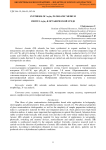
Synthesis of As2Se3 in organic medium
Статья научная
Arsenic (III) selenide has been synthesized in organic medium by using metaarsenite and amorphous selenium. The synthesis was carried out at the temperature range of 433-443 °K, pH >10, during 2-8 hours. Resulting sediment is filtered, washed at first by 0.1 M of acetate acid solution, then by ethyl alcohol and dried at 353 °K. The chemical analysis of the sediment is made, thermal, X-ray phase analyses are carried out, and electron microscope images of microparticles are taken.
Бесплатно
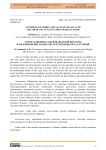
Synthesis of amides and salts of oxalic acid and their use as plant growth regulators
Статья научная
Oxalic acid plays a very important role in the life of plant organisms. In addition, its salts and amide derivatives also have growth-stimulating properties. In this work, we show the results of research in the field of synthesis of amide derivatives of oxalic acid, and also investigated their growth properties using the example of some agricultural crops. Have found that the mono amide of oxalic acid has a stronger effect on the growth of pea seeds compared to the disubstituted amide of this acid. Thus, we can conclude that salts and amide derivatives of oxalic acid have a pronounced regulatory property during the ripening of pea and corn seeds. In this regard, they have been recommended as growth stimulants for these plants in agricultural practice.
Бесплатно
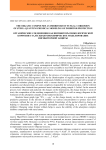
Статья научная
In a published scientific article presents modeled using quantum chemistry package HyperChem version 8.0.7 using semiempirical method ZINDO/1 the process of adsorption of organic sulfur-containing compounds such as iron (available in steel St3S (Poland) in the amount of 97%). Compare and explain the protective effects of corrosion depending on the extent of cathodic polarization of the metal model specimen. This way with high accuracy reflects the process of corrosion protection with mycological content (Penicillium chrysogenum cells) by the chemisorption of organic compounds on the metal surface with the formation of complex compounds. Inhibitor protection carried out with a sample of the metal cadmium plating protected with a current density of 4 A/dm2. As a comparison, the properties and characteristics of some complexes responsible for metal protection, will be referred to secondary data obtained from protected metal cadmium plating sample 1-3a/dm2. In the research process were obtained and analyzed: the charges on the heteroatoms, the charge density (1 atom of iron), the composition of the resulting compounds Fe a ←[SMY], as well as energy diagrams in the formation of the adsorption complex of the studied molecules. Absolute linear graph type “Z% - Feρq”, so the charge density on the iron is a powerful predictive parameter in the mission of inhibitor (at various concentrations) to protect steel from corrosion, without the use of a screening method. Knowledge of the partial effective charges of helping to determine the most powerful adsorption centers belonging to a specific molecule inhibitor. Changing values frontier orbitals helps to assess the stability of the adsorption complex inhibitor compounds with metal atoms.
Бесплатно

